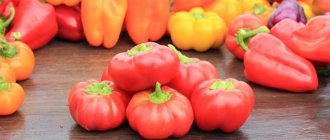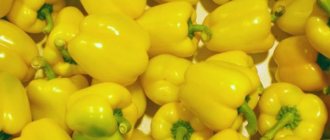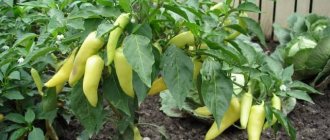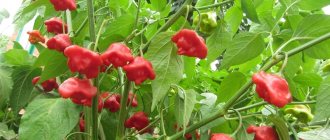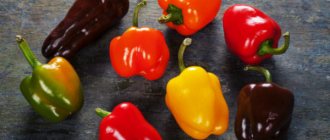Description of sweet pepper Stanley F1, reviews, photos
Medium-early, thick-walled hybrid of bell pepper for open ground, temporary film shelters, greenhouses.
The period from germination to the beginning of ripening is 110-117 days. The bush is closed, 100-130 cm tall. The leaves are medium to large, green to dark green, wrinkled.
In 2007, Stanley F1 sweet pepper was included in the State Register of the Russian Federation for cultivation in open ground and under film covers on private farms.
Fruit characteristics
The fruits are drooping, cube-shaped, glossy, dark green at the stage of technical ripeness, and red to dark red at the biological stage. Number of nests 3-4. The average fruit weight is 75-130 grams (according to reviews, up to 250 g). Wall thickness 8-10 mm. This pepper is suitable for fresh consumption, canning, preparing lecho, and home cooking.
Productivity : 2.3 kg per 1 sq. meters of landings.
Advantages of the variety : resistance to the tobacco mosaic virus, excellent taste and marketability of the fruit.
Taste characteristics, advantages and disadvantages of the variety
Stanley F1 pepper tastes good. But its aroma is weakly expressed. The harvest is used fresh, in snacks and dishes after heat treatment, in canning, and in freezing. The thickness of the walls and meatiness allow ripe peppers to be stored for a long time and travel long distances. Therefore, the variety is often used for sale.
Other items from the list of positive characteristics of bell pepper:
- Beautiful view. Aligned red and green fruits have high-quality commercial properties.
- Compactness in the ground. Dense planting of the hybrid in the garden bed is allowed.
- Early harvest time. Peppers ripen in August.
- Immune protection against TMV.
- The versatility of planting methods - open ground, greenhouse.
This pepper also has disadvantages:
- unsuitability for industrial cultivation;
- relatively modest yield indicators;
- lack of immunity to certain diseases;
- impossibility of propagation by seeds.
Features of growing peppers, planting and care
Sowing pepper seeds for seedlings is carried out 65-75 days before the intended planting of plants in a permanent place. The optimal temperature for seed germination is 26-28°C.
When true leaves appear on the plants, they are transplanted into separate cups with a capacity of 0.3-0.5 liters.
Pepper does not like transplanting, so do not be surprised if after you have transplanted the seedlings into separate containers, they stop growing for a while. You can “smooth out” the stressful state a little by spraying the plants with Epin.
When to plant pepper seedlings in the ground
After the threat of return frosts has passed, the seedlings can be planted in a permanent location. Some people plant in open ground in May, while others only plant under covering material or under film; it all depends on the climatic conditions of your region.
When planting pepper seedlings in the ground for 1 sq. It is recommended to place up to 4 plants per meter of land, no more. Peppers are planted in the ground without being buried, but in exactly the same way as they grew in cups. Pepper plants, unlike tomatoes, very rarely produce lateral roots, so there is no point in deepening them.
Pepper responds well to watering and fertilizing with complex mineral fertilizers. During the summer, 2-3 feedings are usually done.
Your reviews of Stanley pepper and additions to the description will help you evaluate this hybrid more objectively and decide whether to plant it or not.
Diseases and pests
Bell pepper requires careful care; diseases and pests do not bypass its planting. The most common diseases:
- blackleg;
- gray rot;
- anthracnose;
- fusarium wilt;
- top rot.
Blackleg attacks pepper seedlings. Symptoms: darkening of the root area of the stem, signs of rotting. Sick plants are destroyed, the remaining ones are treated with a 3% solution of copper sulfate.
Gray rot can be identified by gray spots on the pods and leaves. This fungal disease is treated with modern fungicides. In a plant suffering from anthracnose, brown spots appear on the leaves and stems, the former dry out, the latter rot. The plant is removed from infected areas and treated with a fungicide.
Bushes infected with fusarium need to be destroyed, the soil should be sprinkled with fungicide and deeply loosened. Top rot is provoked by daily temperature fluctuations, improper watering, and lack of nutrition. The pods suffer. Sick plants need to be properly cared for and treated with a 0.3% calcium chloride solution.
Varieties of thick-walled sweet peppers for open ground
The most resistant to weather changes are grown in unprotected soil. They are usually dependent on sunlight, but are easy to cultivate.
Varieties of thick-walled sweet peppers for open ground
- “Anastasia” is a productive variety of sweet pepper that can bear up to 18 fruits from each bush, and up to 8 kg can be harvested from a square plot. The ripening period is 130 days. The fruits are fleshy, weighing 200-250 g, pericarp - 0.6-0.8 cm. The pulp has a pronounced odor, juicy. The color of the skin is red, the flesh is cherry. Recommended for summer snacks, winter preparations, stuffing, freezing.
- “Kolobok” is an easy species to grow and therefore quite in demand. The vegetable is almost round, which is where the name comes from. The bush grows up to 40 cm. The fruits can ripen even at low temperatures, so the variety is often purchased for cultivation in the Urals and Siberia. The ripening period is 130 days on average, sometimes less. The weight of the fruit is 100 g, the wall is 0.8-1 cm. They are especially convenient to use for stuffing and canning.
- “Fat man” is a sweet pepper, characterized by a record wall thickness, which can reach 1 cm. The fruits themselves are small, 65-130 g each, the pulp contains an abundance of juice and sugar. The ripening period is 115-118 days. This species is often grown for sale, because the fruits not only have commercial quality, but are also suitable for transportation. From a square of plantings you can harvest approximately 4-4.5 kg of pepper.
- "Ox's ear" is a thick-walled pepper that grows up to 70 cm in height. Ripening period is 112-130 days. This variety loves sunlight very much, so it is grown in the most illuminated areas. The color of ripe peppers is bright scarlet, the skin is shiny. The length of the fruit is about 15 cm, the wall thickness is 0.8 cm, the weight is 200 g.
Description and characteristics of the variety
.eic-frame-38096 .eic-frame-38096 .eic-image
Stanley pepper is a hybrid adapted to different conditions. It is cultivated in open and covered beds, in fields and in warm tunnels.
Stanley sweet pepper is an early species. From the moment of germination to technical ripeness, 60-67 days pass.
The value of the hybrid from Holland is its large-scale yield, the huge size of the peppers, and the thickened and fleshy pericarp.
Plants are medium-sized, standard type. They have strong stems, the height of the bushes reaches 70-80 cm. The foliage and branching are moderate. The leaf blades are small and dark green.
What is characteristic of fruits:
- average weight 200-280 g;
- length 15-17 cm;
- prism-shaped;
- diameter at the stalk 13-14 cm;
- thick juicy dense wall 9-11 mm;
- the taste is sweet. with a slight sourness.
Peppers are stuffed and used in fresh dishes. They are added to soups, borscht, and side dishes. Vegetables add a special attractive aroma and flavor to recipes.
The best Dutch thick-walled varieties
Dutch varieties of thick-walled sweet peppers are famous for their high quality. Their seeds have excellent germination, the vegetable itself is distinguished by its yield and pleasant taste.
The best Dutch thick-walled varieties
- "Aristotle X3 R F1" is a hybrid that can be grown without problems in regions with cool, changeable or hot climates. He quickly adapts to the weather. Ripening is mid-early. Bushes are 50 cm long. The fruits are cubic, oblong, weighing 350-450 g. The size of the pericarp is 1 cm. The color is cherry, the skin is shiny. Productivity – 5-5.5 kg/square.
- "Claudio F1" is suitable for cultivation in warm regions. Harvest ripening is observed in 130-140 days. The pepper is 20 cm long and about 10 cm wide. The size of the walls is 10 mm. The color after full ripening is scarlet. The hybrid is resistant to many diseases. From a plant you can collect 3-4 kg of fruit per season.
- "Atlantic F1" ripens in approximately 110-120 days. The fruits grow at 150-190 g. The thickness of the pericarp is 10 mm. The skin is dense, but soft, with shine. Cherry color. Needs plenty of lighting. The productivity of this variety is high. The fruits are best used for canning or fresh eating.
Super early varieties
Super early varieties of thick-walled peppers are grown mainly for sale. Due to their short ripening period, they produce an early harvest, especially if they are grown in a greenhouse using the seedling method.
- “Fat Baron” ripens in just 90 days. There is immunity to many diseases. The pepper is red, bright, with a glossy skin, cylindrical in shape, weight - 300-350 g on average, but there are also giants weighing up to 500 g. Wall thickness - 10 mm. Productivity per bush – 7 kg. The harvest is stored for a long time after harvesting and is suitable for transportation.
- "Zarya F1" matures in about 90 days. The fruits are cone-shaped and, when fully ripe, have a red color. Weight – 100-120 g, wall thickness – 8 mm. The pulp is juicy and aromatic. From a square of plantings you can harvest up to 8 kg of vegetables. The harvest is transportable, with excellent commercial qualities. After collection it is well stored. There is immunity to verticillium. Universal use.
- “Quickly F1” is an early variety for greenhouses and unprotected soil. Ripening occurs in 80-90 days. Pepper in the form of a cone, with a glossy red skin. Weight – 100-120 g. Wall size up to 7 mm. The taste is rich and sweet. Pepper is of commercial quality, suitable for long transportation. It has immunity to viruses and tolerates stressful growing conditions well. Productivity in a greenhouse is up to 9 kg per square, in open ground - no more than 5 kg/m. sq.
Fetal characteristics
Thick-walled hybrids (varieties) are characterized by high yields, which is why summer residents and farmers love them. The main distinguishing characteristic of this type of sweet pepper is the thickness of the pericarp of 8 mm. An important characteristic of any variety is the ripening period in days:
- early up to 100;
- mid-season up to 120;
- late ones up to 150.
Pods that have reached technical ripeness (light green, dark green, cream) are well stored. The shelf life of juicy, fleshy fruits that have reached biological ripeness is shorter.
A pod of any thick-walled variety reaches its maximum weight with high agricultural technology. The colors of thick-walled peppers that have reached biological ripeness depend on the specific variety.
Varieties of large-fruited thick-walled peppers
Gardeners like large-fruited varieties of pepper because they have a marketable appearance and a pleasant taste.
Varieties of large-fruited thick-walled peppers
- “Bel Goy” is a late species for greenhouses and unprotected soil. Grows up to 600 g. Pericarp size is 0.9-1 cm. Bushes grow up to 1.2 meters, but do not take up much space on the site. The variety needs regular feeding and timely watering. Productivity is high and stable.
- “Sun of Italy” is a crop characterized by large fruits - up to 500 g. Ripening occurs in 115-120 days. Can be cultivated outdoors or in greenhouses. The size of the pericarp is 0.6-0.8 cm. The pulp has a pronounced odor, is very tasty, suitable for summer snacks, winter preparations, and stuffing. From a square plot you can harvest 5-6 kg of crop.
- “White Gold” is a variety of vegetable of Siberian selection. Pepper can grow up to 450 g. Pericarp – 1 cm. The fruits are cuboid, pale yellow in color. The crop ripens quickly, but for normal growth the bushes require regular feeding. The variety is suitable for cultivation outdoors or in greenhouses. The harvest takes place from July to August.
Features of sweet pepper Gypsy and recommendations for growing a hybrid
Dutch pepper Gypsy has a very early ripening period and is not demanding in care. It has strong immunity and is suitable for growing in temperate climates.
Gypsy Pepper Seeds
weight of one fruit is approximately 110 g
The variety is characterized by uniform fruit size
Origin of the Gypsy pepper hybrid
Origin: Holland, imported to Russia by Seminis. The hybrid variety Gypsy gets along well in our soil due to its characteristics, especially due to its early ripening period. The hybrid was created in the early 2000s. Scientists wanted to develop a variety that would be characterized by super early growth, strong immunity and resistance to weather changes, especially the onset of frost.
Characteristics and description
The pods of the hybrid can already be added to fresh dishes two months after planting the seedlings in the soil. To get an early harvest, seeds for the greenhouse are sown already in February, and picking is not carried out due to the weak root system.
Appearance of the bush and fruits
The plant is not tall, reaches approximately 0.6 m, and is not too branched. The stems are thin and can break due to the slightest mechanical damage. The roots do not go deep into the soil; they are practically on the surface (about 0.25 m). The leaves are small, wide, bright green.
The bush begins to bloom 2.2 months after sowing; the flowers are small and white; there are both female and male flowers. Flowering continues almost until frost. The bush is self-pollinating, but cross-pollination is also possible.
Very often, Gypsy pepper is cross-pollinated with bitter crops, and its taste becomes overly pungent, so to avoid this, plants are planted farther apart (at least at a distance of 0.15 m). The pods are not very large, but have a beautiful shape. This hybrid is distinguished by the uniform size of the entire crop, the weight of one is approximately 110 g.
The best varieties of thick-walled peppers for the Moscow region
In central Russia, many varieties of pepper can be grown.
The best varieties of thick-walled peppers for the Moscow region
- “Red Giant” is a productive variety of thick-walled sweet pepper, yielding approximately 10 kg of pepper per bush. The bushes are tall, up to 1.2 m. The fruits are cube-shaped, about 20 cm long and about 10 cm wide. Average weight is 250-300 g. The pericarp size is up to 1 cm. After full ripening, the walls acquire a pleasant cherry color. The taste is sweet, the aroma is delicate, the use is universal.
- “Novogoshary” is an early species, ripening in 110-115 days. The fruits are large, flat-round in shape. The skin color is red. Vegetable weight is 90-140 g. Pericarp thickness is 1 cm, shelf life is excellent, transportability is acceptable. This variety can be used for winter preparations and stuffing.
- “Big Boy” is a thick-walled pepper that ripens on average in 100-105 days. A cherry-colored vegetable, juicy, sweet, 300 g each. The thickness of the pericarp is 0.8 cm. The yield per square meter is about 7.5 kg. The use of the crop is universal.






